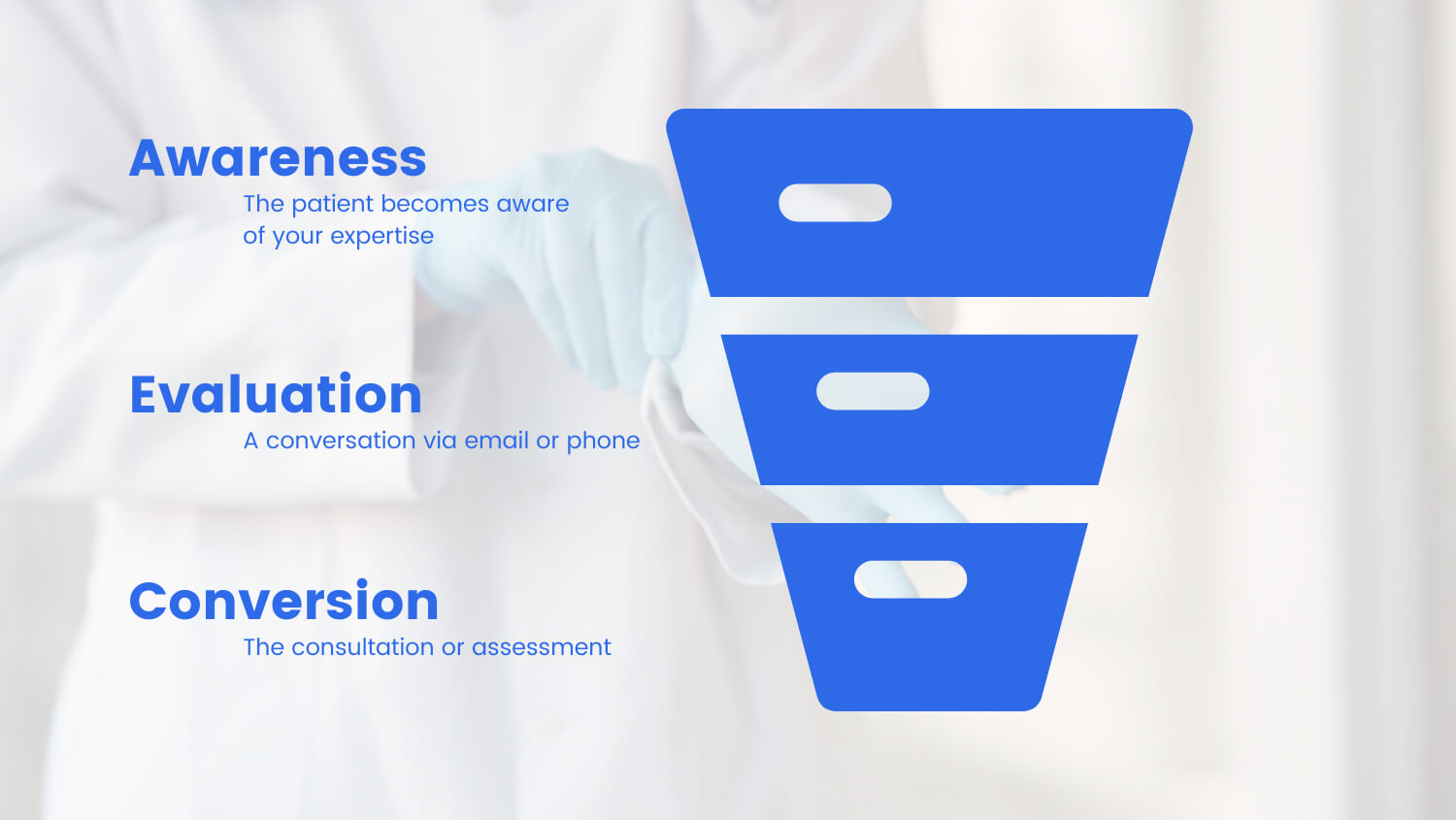blog tips for doctors
Five simple blog habits to get more patients and referrals in no time
Five simple blog habits to get more patients and referrals in no time

Kris Borgraeve
November 11, 2021
Turbocharge your blog by choosing the right audience
blog tip #1 for doctors in private practice
As a specialist doctor, your blog is not for everyone. The first step is to clearly identify your target audience.
Blogs targeted at GPs
If your blog is targeted at the General Practitioners and Physicians in your catchment area, you will choose a specific strategy. The content will be in line with the most frequently asked questions. Attending networking events with general practitioners and physicians is a great way to map the key topics for your blog. Writing an article that cuts through the noise in the specialist/general practitioner conversation is an art: you will want to include concise data, validated by peer-reviewed research, packaged in a way that your colleague can digest, even in a hurry on a smartphone. When you target the local general practitioner, always focus on knowledge that makes their work easier, not on showing off the depth of your specialty.
Blogs for the general public
Your blog strategy for general consumers and patients needs a clear vision. In obstetrics, women’s health and fertility, a whole realm of lifestyle topics allow you to position yourself as an educator and thought leader. In orthopaedics, education on injuries and surgery types will be the foundation for your blog articles.
As you decide the patient types you would want to become your patients, the most efficient way to describe your target audience is to go over these parameters:
- Catchment area: As simple as it may sound, get really clear on the suburbs that are relevant for your private practice. If you are associated with multiple hospitals, define the action radius they cover. Do your market research and get really clear on the flow of patients to these hospitals. This matters because it will define the locations you mention in your blog.
- Conditions, treatments and surgery types: Choose the top income avenues for your private practice and focus on the top 3. This will give your blog more credibility in Google Search because your topics will have a clear common set of topics.
- Demographics: Choose the types of people you want to work with. The elite athletes with shoulder and knee injuries. The pregnant ladies who are adamant about a natural birth? The 21-year-olds who want 2 types of plastic surgery at once? Or not. For some types of medical treatment and for elective surgeries, demographics and sociographics matter.
As you choose your target audience, you can dig deeper into patient search behaviour data to learn what different patients or consumers are searching for.
The failproof methodology we use with our customers is a whole-brain approach:
- Left brain information focuses on answering the most frequently asked questions. Data can help you understand what patients type into Google Search.
- Right brain information helps you build rapport. Share a personal view on the conditions you treat or the services you offer, and focus on helping the patient understand who you are as a human being. Sharing why you are a specialist doctor and opening up about your own story is a proven way to increase engagement.
How to create effective educational content?
blog tip #2 to be a leading educator
- Google visibility, or SEO: Each article becomes a mini-magnet for Google Search, making you more visible. Check our articles on SEO ranking factors and quality content as defined by Google.
- Conversions: A well-written article based on keyword research answers the patient’s questions and builds trust. Research shows that this keeps patients on your website for longer and this leads to spectacular increases in conversions and patient numbers.
- Check out these posts on Egg Freezing, Motor vehicles and workers compensation, or Managing anxiety.
Informational content to help the patient
blog tip #3 for your medical blog
With strictly informational content you are not necessarily educating. All you do is organise the information in one easy place (the blog article) so the patient can easily bookmark it or forward it to a relative.
Of course, essential information has its place on your website on fixed pages. But it won’t harm to add a fresh summary of information in a blog. Your blog article then appears at the top of your news feed, and if your website is built to the latest standards it will have a date stamp that helps patients see how recent this is. Ever-changing procedures in regards to COVID-19 are an obvious example of how this can be very relevant.
A blog article that is just there to inform could cover other typical topics: This new allied health team member who just joined your team. An anniversary at the practice. Perhaps you have just won an award or you are celebrating the new brand colours or a new clinic location? Sometimes information simply creates a feeling of activity that validates your reputation and makes it more dynamic.
If you are introducing new services or treatments, and within the framework of regulations that may apply in your jurisdictions, use your blog to create a flavour of freshness to inform your community of referring general practitioners and your prospective patients.
This type of blog post can also increase traffic to your website, provided everything is published with the right tags and keywords and on a healthy website.
The hidden power of funnel marketing
blog tip #4 to excel at content marketing
Blogs are widely recognised as a clever marketing technique. But why? We have covered the power of educational and informational blogs for your private practice. The question I often get in a Strategy Session is whether this actually helps you grow your practice.
The best way to answer this question is to look at the mechanics of funnel marketing. We don’t say yes to an offer we receive, as consumers, right? The same applies to your patient. They have a reason to start looking into information about a specific symptom, condition or treatment. The choice is important, and it helps to be aware of the process. In marketing, we call it a funnel because it guides the consumer to the desired outcome: a conversion.
Funnel marketing aims to create awareness with as many people as possible. A blog article makes the patient aware of your expertise. And because you have targeted the right audience, and chosen an angle that either informs or educates the patient, you are delivering value.
The patient is one step closer to evaluating if your service is a good match. This depends on your follow-up systems and the quality of your practice management. Ideally, your team emails or calls the patient and makes the patient feel welcome, cared for and in good hands.
The next step of a funnel is the actual conversion. This is not as black-and-white as signing up for bariatric surgery, a rhinoplasty procedure or sedation dentistry. It could be as simple as redirecting a referral so the patient books an appointment with you. Or it could be a booking for an information session on diet, lifestyle habits or recovery tips.
Think about your blogs as elements in a much bigger picture. That bigger picture is the one of a healthcare brand that creates awareness and turns you into a leading specialist.
Check out the funnel graphic below to see this in action.

Double or triple the impact of every blog post
blog tip #5 to create ongoing practice growth
As a rule, most surgeons and specialist doctors I speak to are not ready to spend their Saturday afternoons writing blog posts. Fair enough. That is why doubling or tripling the output of every blog article is probably something that resonates with you.
Let’s go over a few ways to repurpose every blog:
- Break down the content in snackable social media posts
- Post snippets on platforms, in forums and groups, referring to your full post
- Retarget website visitors with a social media ad to your blog posts
- Make sure your blog is also an ideal landing page, optimised for Google search and with a clear call-to-action
Having this extra layer of optimisation built-in is a valid reason to work with a specialised marketing agency for the production of your blog campaign. You avoid the pitfall of blogging for the sake of blogging. With optimised and strategically chosen content, targeting the right audience and using angles that convert well, focused on repurposing and booking more patients, you are on track to create an unbeatable leadership profile in no time.
Let’s talk about your blog strategy
blog strategy for doctors
- Tags: Patient acquisition





